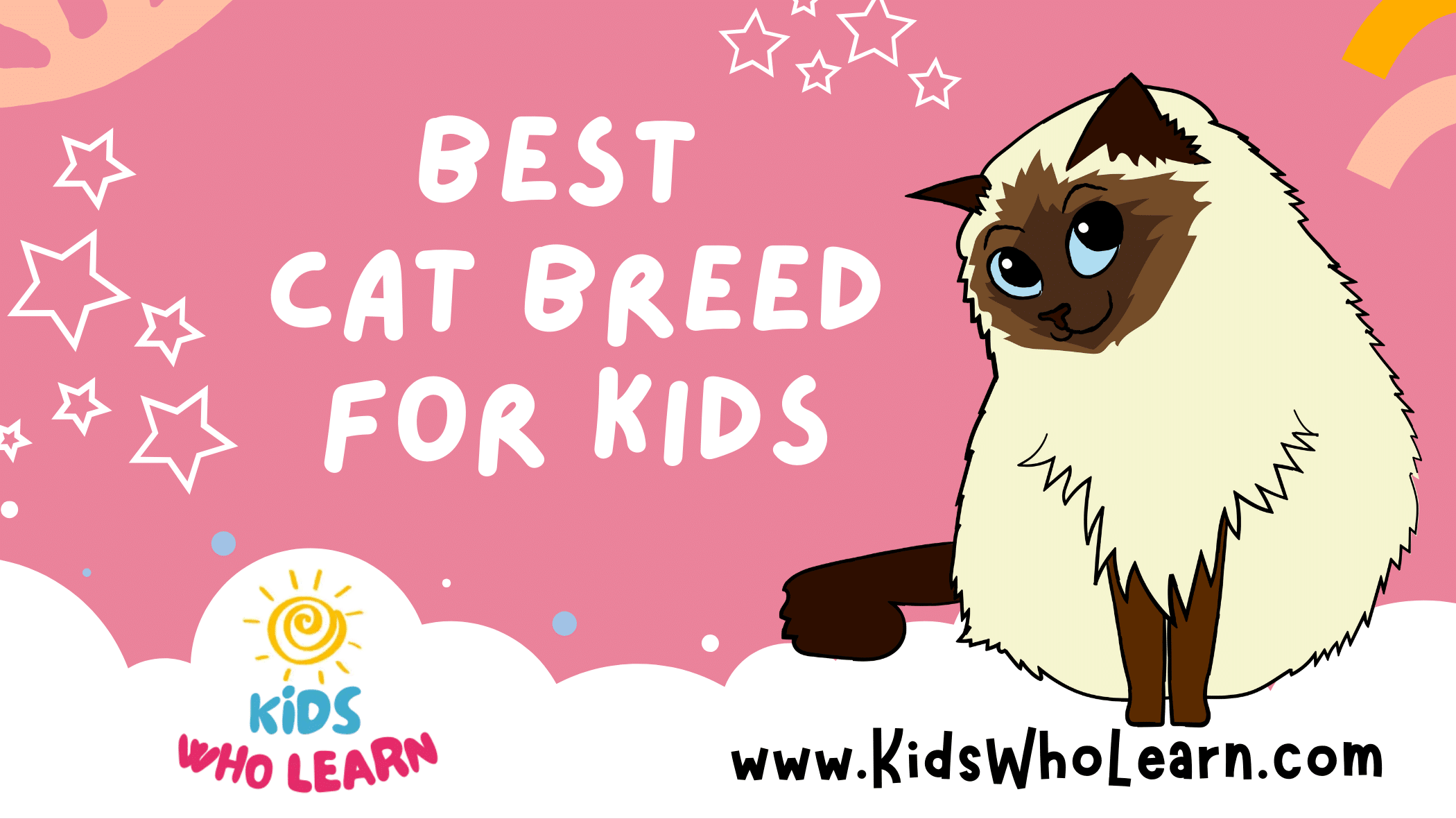Selecting the ideal cat breed for kids involves balancing a friendly temperament with the practicalities of maintenance and health. When considering a family cat, it’s essential to choose a breed known for its gentle and sociable nature. Some breeds display traits that make them more suited for lively households with children. These cats typically have patient and playful personalities, able to handle the energy and unpredictability of young family members.
In addition to a compatible temperament, potential health issues and grooming needs are significant factors. A breed with minimal health concerns and low-maintenance grooming could be a better choice for busy families. Moreover, owning a cat can positively impact child development by teaching responsibility, nurturing empathy, and providing companionship. Thus, picking a breed that effortlessly blends with your family’s lifestyle and enriching your home environment is critical.
Key Takeaways
- Choose a cat breed with a friendly and patient temperament for compatibility with children.
- Consider breeds with fewer health issues and lower grooming needs for easier maintenance.
- Owning a cat can contribute positively to your child’s development and the family dynamic.
Understanding Cat Temperaments
When selecting a cat breed for your family, it’s essential to match the cat’s temperament with the energy and dynamics of your household, especially when children are present.
The Importance of Personality in Cat Breed Selection
Cat breeds exhibit a wide range of personalities; finding a breed that complements your family’s lifestyle is crucial. For instance, if your family is active and playful, you’ll want a cat breed known for being sociable and energetic. Conversely, a quieter household might appreciate a cat with a more patient and gentle demeanor. It’s also important to find a breed that demonstrates loyalty and affection, ensuring that it forms a strong bond with each family member.
- Traits to seek for an active, playful household:
- Playful
- Energetic
- Sociable
- Traits suitable for a quieter environment:
- Gentle
- Patient
- Affectionate
Behavioral Traits Suitable for Children
When considering cats for a home with kids, prioritize breeds that are known to be sweet, loving, and affectionate. They should have the patience to tolerate the unpredictable behavior of children and the intelligence to adapt to various situations. Playfulness and curiosity can also be beneficial, encouraging interactive play that can help children develop respectful and gentle behavior towards animals.
- Ideal behavioral traits for kid-friendly cats:
- Gentle and patient
- Affectionate and loving
- Playful and curious
Remember, you’re looking for a cat that not only tolerates children but enjoys their company. The breed should match the energy level of your kids—active breeds for energetic children and calmer breeds for less active households.
| Energy Level | Traits | Suitable Breeds |
|---|---|---|
| High | Playful, Active, Sociable | Abyssinian, Siamese |
| Low | Sweet, Gentle, Loyal | Ragdoll, British Shorthair |
In your selection process, ensure that the breed’s temperament aligns with your family’s needs and your children’s personalities to foster a harmonious and lasting bond.
Popular Cat Breeds for Families
When selecting a cat breed for your family, consider breeds known for their sociability and adaptability to living with children.
Characteristics of Family-Friendly Cat Breeds
Gentleness and Tolerance: The ideal cat breed for families with kids should exhibit a gentle nature. For instance, Ragdoll cats are known for their docile temperament. Maine Coons, often referred to as ‘gentle giants’, are also renowned for their friendly behavior. Both breeds tend to be patient, which is essential in a household with children.
Affection and Interaction: Cats that seek out human interaction make for excellent family pets. Birman and Siamese cats are typically very affectionate and enjoy being part of family activities.
Low Maintenance: Consider the grooming requirements. Breeds like the short-haired American Shorthair are preferable for busy families because of their low maintenance coats.
Health and Longevity: Opt for breeds with a reputation for robust health. Persian cats, while they have longer fur that requires regular grooming, are a popular choice due to their sweet temperament and strong health when properly cared for.
Adaptable Breeds for Dynamic Family Environments
Adaptability: A family-friendly cat must be adaptable. Breeds like the Burmese, Russian Blue, and Scottish Fold are known for their ability to adapt to changes in the household dynamic, making them suitable for family life.
| Breed | Adaptability | Tolerance | Maintenance | Suitability |
|---|---|---|---|---|
| Ragdoll | High | High | Moderate | Excellent |
| Maine Coon | High | High | Moderate | Excellent |
| Birman | Moderate | High | Moderate | Very Good |
| Siamese | High | Moderate | Low | Very Good |
| American Shorthair | High | High | Low | Excellent |
| Persian | Moderate | High | High | Good |
| Burmese | High | High | Low | Excellent |
| Russian Blue | High | Moderate | Low | Very Good |
| Scottish Fold | High | High | Low | Excellent |
| Norwegian Forest Cat | Moderate | High | High | Good |
- Compatibility with Dynamics: Cats that integrate well with the ebb and flow of family life tend to be less stressed and more content in busy households. The Norwegian Forest Cat is another breed that, with its laid-back nature, can fit into the family dynamic.
In choosing your family pet, prioritize breeds that match your family’s lifestyle and interaction level to ensure a harmonious relationship.
Health and Maintenance Considerations
When selecting a cat breed for children, it’s crucial to consider how grooming needs and energy levels can affect your family’s lifestyle. The right balance of these elements will ensure a harmonious match between your new pet and your household.
Grooming Requirements for Kid-Friendly Cats
Short-haired breeds such as the American Shorthair require minimal grooming, making them ideal for busy families. These cats benefit from a weekly brushing session to keep their coats shiny and reduce shedding. In contrast, long-haired breeds like the Persian demand more time and attention. Daily combing is essential to prevent tangles and mats in their luxurious fur.
Grooming Needs Quick Reference:
- American Shorthair: Weekly brushing
- Ragdoll: Bi-weekly combing
- Persian: Daily grooming
Understanding Exercise Needs and Energy Levels
Cat breeds vary widely in their exercise needs and energy levels. The Devon Rex and Cornish Rex, for instance, are highly energetic and active, requiring daily interactive play sessions to keep them physically and mentally stimulated. Meanwhile, the Ragdoll is often more laid back and content with short play periods interspersed with relaxation.
Exercise & Energy Levels Overview:
- Playful Cats (Devon Rex, Cornish Rex):
- Exercise: Daily interactive play
- Energy: High
- Low-Maintenance Cats (American Shorthair, Ragdoll):
- Exercise: Moderate, with play tailored to the cat’s interest
- Energy: Moderate to Low
The Role of Cats in Child Development
Owning a cat as a family pet can be a valuable part of your child’s growth, teaching them vital life skills through daily interactions.
Teaching Responsibility and Empathy
When you introduce a cat into your family, your child has the opportunity to develop a sense of responsibility. Kids learn to care for another living being by fulfilling their pet’s basic needs such as feeding, grooming, and ensuring the cat has a clean living space. Ragdoll and Maine Coon breeds, known for their gentle and playful nature, are particularly suitable for families as they are typically patient and kid-friendly.
Caring for a cat also fosters empathy in children. They learn to recognize and respect the feeling of their pets, growing in emotional intelligence. Understanding a cat’s need for companionship and comfort can be a stepping stone in a child’s emotional development.
Exposing your child to the responsibilities of pet care, especially with affectionate cat breeds, has a significant impact on their maturation. It teaches them the importance of consistency and nurturing in relationships, whether with pets or people.
Choosing the Right Cat for Your Family
Selecting the perfect cat breed for your family involves understanding various breed characteristics and how they align with your family’s lifestyle.
Factors to Consider When Selecting a Cat Breed
- Size: The size of the cat is an important consideration. A larger breed like the Maine Coon is robust and can handle the energetic play of children, but it also requires more space and food.
- Personality: A cat’s personality is crucial. For instance, Ragdolls are known for their gentle and affectionate nature, making them excellent companions for kids. Conversely, some breeds may be less patient with the loud and sudden movements of young children.
- Kid-Friendly: Look for breeds renowned for their compatibility with kids. The sociable and playful nature of a Siamese cat can suit an active family, while their intelligence makes them engaging pets for curious children.
- Energy Level: Consider the breed’s energy level in relation to your family’s lifestyle. Active families may prefer a cat with high energy, whereas a more sedate and calm breed might be a better fit for families that prefer a relaxed environment.
- Hypoallergenic Qualities: Hypoallergenic breeds can be a good choice for families with allergy concerns. While no cat is completely hypoallergenic, some breeds produce fewer allergens than others.
Integrating a Cat into Your Home
When you decide to bring a new cat into your family, particularly one that is gentle and social, preparing your household for their arrival is crucial to ensure a smooth transition.
Preparing Your Household for a New Cat
- Create a Safe Space: Designate a quiet room where your new cat can settle without feeling overwhelmed. Place a comfortable bed, food, water, and a litter box inside.
- Child-proofing: Inform your children about the importance of being gentle and calm around the new pet to help foster a playful yet respectful relationship.
- Introduce Scent: Before your cat arrives, spread its scent using a blanket or toy. This can help your family, including existing pets, to get accustomed to the new member.
- Pet Supplies:
- Food and Water Bowls: Purchase bowls that are stable and easy to clean.
- Litter Box: One per cat, plus an extra, placed in accessible, yet private spots.
- Scratching Posts: These are essential for claw maintenance and to prevent furniture damage.
- Toys: Various toys can provide necessary stimulation for your cat’s playful nature.
- Establish Rules: Set and communicate clear rules for everyone, including:
- Feeding: Maintain a consistent feeding schedule.
- Handling: Teach proper ways to pick up and handle the cat to avoid injury or stress.
- Introductions: Gradually introduce the cat to different areas of the house and other family members.
Correctly preparing your home and family for a new cat, especially when considering children and specific cat breeds, establishes a firm foundation for a harmonious living environment.
Conclusion
Selecting the right cat breed for your family involves considering your children’s needs and the cat’s characteristics. You want a pet that is both sweet-natured and easygoing. Certain cat breeds stand out for their relaxed demeanor and even-tempered nature, making them suitable companions for younger family members.
- Ragdoll: Known for their gentle and laid-back personality.
- Maine Coon: Friendly giants that are sociable and patient.
- Birman: Affectionate and calm, good with children.
- British Shorthair: Placid and affectionate, requiring minimal grooming.
For active families, you might prioritize breeds with a playful but gentle behavior. It’s important for your peace of mind and the safety of your children that the cat you bring home is amenable to a lively household.
In your journey to find the ideal feline friend, seek breeds renowned for their friendly dispositions. Visit breeders, consult with veterinarians, and interact with different cats before making a decision. Your goal is to find a cat that complements your family’s lifestyle and provides joy and companionship for everyone.
Remember, while breed tendencies are a guide, individual personalities vary. Take time to get to know the cat you plan to introduce to your children to ensure a harmonious home life for your new pet and family.
Additional Considerations
Before selecting the best cat breed for your children, take into account specific considerations such as the potential for allergies and the financial perspective of cat ownership.
Allergies and Hypoallergenic Cat Breeds
If allergies are a concern in your family, it’s crucial to focus on hypoallergenic cat breeds. These breeds may produce fewer allergens than others, but no cat is completely allergen-free. Hypoallergenic breeds include:
- Oriental: Featuring a short, fine coat, Orientals are known for producing fewer allergens.
- Siberian: Despite their long fur, Siberians are said to have lower levels of the Fel d 1 protein, which is a common allergen.
- Balinese: Often considered the long-haired version of the Siamese, Balinese cats also produce less Fel d 1 protein.
The Cost of Cat Ownership
The financial responsibilities of owning a cat should not be underestimated. Your family budget must account for:
- Initial costs: adoption fees, spaying/neutering, microchipping, and initial medical exams.
- Ongoing costs: food, litter, toys, grooming, annual vet check-ups, and potential health issues.
| Expense | Initial Cost | Annual Cost |
|---|---|---|
| Adoption | $50 – $150 | – |
| Spaying/Neutering | $150 – $300 | – |
| Initial Medical Exam | $50 – $100 | – |
| Food | – | $120 – $500 |
| Litter | – | $120 – $200 |
| Toys & Accessories | $10 – $100 | $50 – $100 |
| Vet Visits | – | $50 – $300 |
Keep in mind that while some breeds like the Siamese, Japanese Bobtail, and Tonkinese are known for their social and affectionate nature—ideal for families with children—they might have different long-term care costs due to breed-specific health issues. Budgeting for a cat is an ongoing responsibility that can span the lifetime of your pet, which can be more than a decade.
Engaging Activities for Kids and Cats
Creating fun and engaging activities for kids and cats strengthens their bond and provides both with stimulating entertainment. Your careful selection of games and training exercises can ensure safety and enjoyment for your energetic and curious feline friend, as well as for your playful child.
Interactive Games and Training
Laser Pointer Chase:
A laser pointer can provide hours of entertainment for your active cat. Guide the laser dot along the floor and walls and allow your cat to give chase. This game helps in improving the cat’s agility and keeps them physically active. Always supervise this activity to ensure your cat doesn’t become frustrated by the ever-elusive dot.
- Safety Tip: Never point the laser directly into anyone’s eyes.
Feather and Wand Toys:
Use a wand toy with feathers or other attachments to simulate prey. It’s a great way for kids to interact with cats, fostering gentle and respectful play. Move the wand through the air and across the floor to mimic the movements of a bird or small rodent, encouraging your cat to leap and pounce.
- Play Session Advice: Limit play sessions to about 15 minutes to prevent overexertion.
Box Forts:
Construct a fort out of boxes with your kids for the cats to explore. Cut out doors and windows for your intelligent and curious cat to peek through and navigate, satisfying their instinct to investigate.
- Fun Tip: Hide treats in different compartments to turn exploration into a rewarding game.
Trick Training:
Cats can learn tricks just like dogs, especially when they are young and impressionable. Use positive reinforcement techniques to teach your intelligent cat simple commands like ‘sit’, ‘high five’, or ‘come’. Treats can be effective motivators.
- Training Sessions: Keep them short and sweet, no more than 10 minutes at a time, to maintain your cat’s attention.
Interactive Feeding Toys:
Engage your cat’s mind with puzzle feeders or balls that dispense food as they play. This taps into their natural hunting instincts and can be quite entertaining for kids to watch and participate in setting up.
- Important: Choose the appropriate size toy for your cat to prevent any choking hazards.
Obstacle Course:
Set up a homemade obstacle course with tunnels, jumps, and weave poles. Kids can guide their feline friends through the course using a wand toy or by calling them. This activity can help develop your cat’s coordination and is a fun way for your child to teach their pet.
- Safety First: Keep the course simple to prevent any injuries to your playful cat.
Frequently Asked Questions
When selecting the best cat breed for your children, consider temperament, energy level, and hypoallergenic qualities. These FAQs will help you make an informed decision.
What factors should be considered when choosing a cat breed for a family with children?
You should consider the cat’s temperament, grooming needs, and activity level. A child-friendly cat should be patient, sociable, and not overly aggressive.
Which cat breeds are known for being particularly patient and tolerant with kids?
The Ragdoll and the Maine Coon are renowned for their gentle, patient nature with children. They enjoy company and being part of family activities.
What breed of cat is recommended for families with allergy concerns?
The Siberian cat has lower levels of the protein Fel d 1, known to cause allergic reactions. Similarly, the Devon Rex and Sphynx are considered better for allergy sufferers due to their coat type.
At what age is it most appropriate for a child to start taking care of a cat?
Children around the age of 6 can begin learning to care for a cat with guidance, reinforcing responsible pet ownership.
Are there specific cat breeds that are better suited for indoor living with a family?
The British Shorthair and the Persian are ideal for indoor living, requiring less space for exercise and having a calm demeanor suitable for home environments.
How do certain cat breeds interact with other family pets, such as dogs?
The American Shorthair and the Birman are adaptable breeds that can coexist peacefully with dogs. These breeds are known for their easygoing personality when introduced properly.













